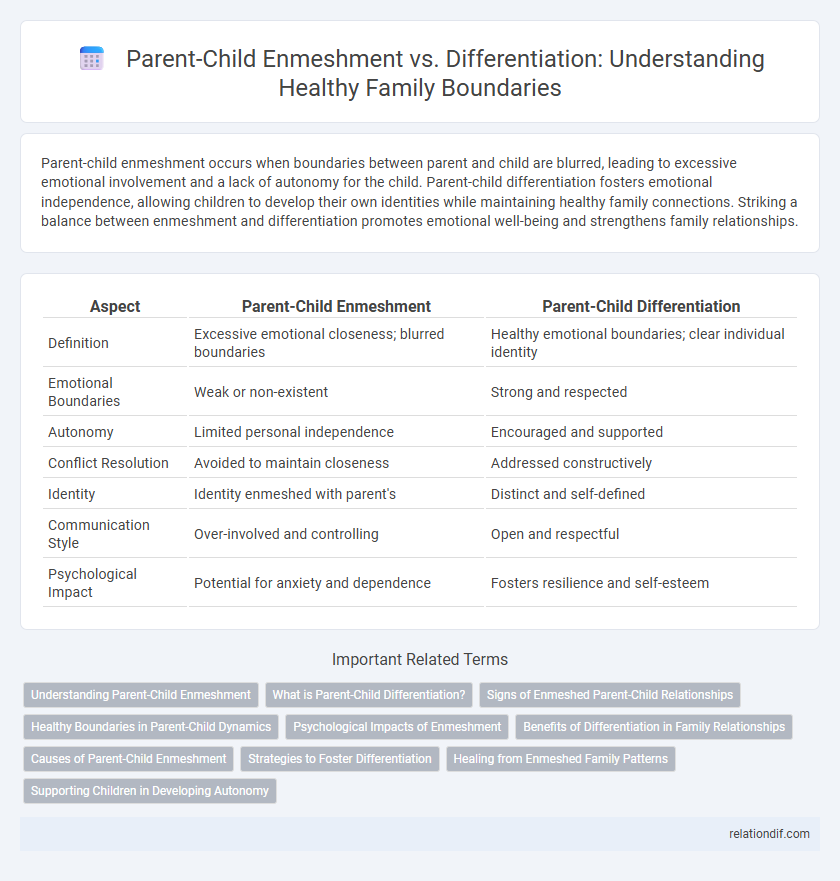Parent-child enmeshment occurs when boundaries between parent and child are blurred, leading to excessive emotional involvement and a lack of autonomy for the child. Parent-child differentiation fosters emotional independence, allowing children to develop their own identities while maintaining healthy family connections. Striking a balance between enmeshment and differentiation promotes emotional well-being and strengthens family relationships.
Table of Comparison
| Aspect | Parent-Child Enmeshment | Parent-Child Differentiation |
|---|---|---|
| Definition | Excessive emotional closeness; blurred boundaries | Healthy emotional boundaries; clear individual identity |
| Emotional Boundaries | Weak or non-existent | Strong and respected |
| Autonomy | Limited personal independence | Encouraged and supported |
| Conflict Resolution | Avoided to maintain closeness | Addressed constructively |
| Identity | Identity enmeshed with parent's | Distinct and self-defined |
| Communication Style | Over-involved and controlling | Open and respectful |
| Psychological Impact | Potential for anxiety and dependence | Fosters resilience and self-esteem |
Understanding Parent-Child Enmeshment
Parent-child enmeshment occurs when boundaries between parent and child become blurred, leading to excessive emotional involvement and loss of individual autonomy for the child. Understanding parent-child enmeshment is crucial for recognizing patterns that hinder a child's emotional development and independence. Differentiation, contrastingly, emphasizes healthy boundaries, allowing the child to develop a distinct identity while maintaining a supportive relationship with the parent.
What is Parent-Child Differentiation?
Parent-child differentiation refers to the development of emotional and psychological boundaries that allow children to establish their own identity while maintaining a healthy connection with their parents. This process involves recognizing and respecting individual feelings, thoughts, and needs, fostering autonomy and self-regulation. Differentiation supports balanced family dynamics by enabling open communication and reducing dependency, which is essential for personal growth and resilience.
Signs of Enmeshed Parent-Child Relationships
Signs of enmeshed parent-child relationships include a lack of clear personal boundaries, where the child's emotions and decisions are overly controlled or influenced by the parent. Children in enmeshed families often struggle with autonomy, showing difficulty in making independent choices or expressing individuality. This dynamic can lead to blurred roles, emotional dependency, and impaired development of self-identity.
Healthy Boundaries in Parent-Child Dynamics
Healthy boundaries in parent-child dynamics promote clear differentiation, fostering individual autonomy while maintaining emotional connection. Parent-child enmeshment blurs these boundaries, causing emotional overdependence and hindering personal growth. Establishing balanced limits encourages mutual respect and supports the development of a secure, independent identity within the family system.
Psychological Impacts of Enmeshment
Parent-child enmeshment leads to blurred boundaries, causing children to struggle with autonomy and develop low self-esteem due to excessive parental involvement in their emotional lives. Psychological impacts include heightened anxiety, identity confusion, and difficulties in establishing healthy interpersonal relationships later in life. Differentiation promotes emotional independence, allowing children to form a distinct sense of self and resilience against relational stressors.
Benefits of Differentiation in Family Relationships
Parent-child differentiation fosters healthy boundaries, promoting individual autonomy and emotional regulation within family dynamics. It enhances communication by enabling authentic self-expression and mutual respect, which reduces conflict and supports psychological well-being. Families embracing differentiation tend to develop resilience and adaptability, strengthening long-term relational satisfaction and growth.
Causes of Parent-Child Enmeshment
Parent-child enmeshment often arises from parental over-involvement and blurred emotional boundaries, leading to a lack of individual autonomy for the child. Factors such as parental anxiety, unresolved trauma, and a need for control contribute to excessive dependence and emotional fusion between parent and child. This dynamic disrupts healthy differentiation, impairing the child's development of personal identity and self-regulation skills.
Strategies to Foster Differentiation
Encouraging open communication and respecting individual boundaries promotes healthy parent-child differentiation by allowing children to develop autonomy while maintaining emotional connection. Setting clear expectations and supporting independent decision-making helps prevent enmeshment, fostering a balanced family dynamic. Consistent reinforcement of personal identity and emotional regulation skills strengthens the child's ability to differentiate within the family system.
Healing from Enmeshed Family Patterns
Healing from parent-child enmeshment requires establishing healthy boundaries that promote individual autonomy while nurturing emotional connection. Differentiation encourages parents and children to develop separate identities, fostering mutual respect and reducing codependency. Therapeutic interventions such as family therapy and consistent communication strategies help break enmeshed patterns and support long-term emotional well-being.
Supporting Children in Developing Autonomy
Supporting children in developing autonomy requires balancing parent-child differentiation, which fosters independence and healthy boundaries, against the risks of parent-child enmeshment that can hinder a child's self-identity. Encouraging decision-making, respecting personal space, and validating emotions helps children build confidence and self-regulation skills essential for autonomy. Family therapists emphasize structured emotional support and clear roles to promote differentiation without emotional detachment.
Parent-child enmeshment vs Parent-child differentiation Infographic

 relationdif.com
relationdif.com